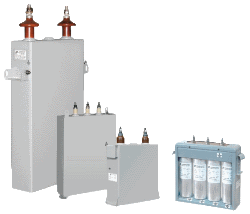
The main consumers of electricity in industry are inductive receivers such as induction motors and transformers. Their work is connected with the consumption of reactive energy to create electromagnetic fields. Reactive power produces no useful work, but circulates between the receiver and the current source leads to an additional load generators and power lines, and hence reduces the power factor of the network. All this increases the loss of electric energy to heat the wire and cable networks, as well as the windings of electrical machines, leads to the need to increase the apparent power generators and transformers in stations, increases the voltage fluctuations, as well as entails underutilization of capacity prime movers.
Generation of reactive power in the consumer usually called reactive power compensation, and the most convenient and economical source of its power factor correction capacitors are performing functions energy saving and improve the quality of electric energy equipment.
Low-voltage power factor correction capacitors apply for power factor correction of AC electric plants at frequency 50 Hz and to complete capacitor banks.
Low-voltage power factor correction capacitors
|
Type designation
|
Capacitance,
µF
|
Tangent
of loss
angle
|
Current
frequency,
Hz
|
Overall dimensions
(height with
insulator), mm
|
Weight,
not more,
kg
|
Normative
document
|
|
KEC0-0,38-10 2U3
|
221,00
|
(1,6±0,9)?10-3
|
50 |
380?135?337
|
16,0
|
According to
approved
technical
requirements
|
|
KEC0-0,38-10 3U3
|
380?135?285
|
|||||
|
KEC1-0,38-20-2U3
|
441,00 | 380?120?487 |
26,0
|
|||
|
KEC1-0,38-20-3U3
|
380?120?435 | |||||
|
KEC1-0,38-25-2U3
|
551,48
|
380?135?487
|
||||
|
KEC1-0,38-25-3U3
|
380?135?435 | |||||
|
KEC1-0,38-27-2U3
|
595,48
|
380?135?487 | ||||
|
KEC1-0,38-27-3U3
|
380?135?435 | |||||
|
KEC2-0,38-36-2U3
|
794,00
|
380?120?787
|
54,0
|
|||
|
KEC2-0,38-36-3U3
|
380?120?735 | |||||
|
KE2-0,38-40-2U3
|
882,00
|
380?120?787 | ||||
|
KEC2-0,38-40-3U3
|
380?120?735 | |||||
|
KE2-0,38-50-2U3
|
1102,00
|
380?135?787 | ||||
|
KEC2-0,38-50-3U3
|
380?135?735 | |||||
|
KEC1-0,4-20-2U3
|
398,00
|
380?120?487
|
27,0
|
СТ 1474-1917-
-АО-4-042-2013 |
||
|
KEC1-0,4-20-3U3
|
380?120?435 | |||||
|
KEC1-0,4-25-2U3
|
497,00
|
380?120?487 | ||||
|
KEC1-0,4-25-3U3
|
380?120?435 | |||||
|
KEC1-0,4-30-2U3
|
597,00
|
380?135?487 | ||||
|
KEC1-0,4-30-3U3
|
380?135?435 | |||||
|
KEC2-0,4-40-2U3
|
796,00
|
380?120?787
|
54,0
|
|||
|
KEC2-0,4-40-3U3
|
380?120?735 | |||||
|
KEC2-0,4-50-2U3
|
995,00
|
380?120?787 | ||||
|
KEC2-0,4-50-3U3
|
380?120?735 | |||||
|
KEC2-0,4-60-2U3
|
1194,30
|
380?135?787 | ||||
|
KEC2-0,4-60-3U3
|
380?135?735 | |||||
|
KEC1-0,5-38-2U3
|
484,00
|
380?120?487
|
27,0
|
|||
|
KEC1-0,5-38-3U3
|
380?120? 449
|
|||||
|
KEC2-0,5-60-2U3
|
764,00
|
380?120?787
|
54,0
|
|||
|
KEC2-0,5-60-3U3
|
380?120?749 | |||||
|
KEC2-0,5-67-2U3
|
853,50
|
380?120?787 | ||||
|
KEC2-0,5-67-3U3
|
380?120?749 | |||||
|
KEC2-0,5-75-2U3
|
955,00
|
380?120?787 | ||||
|
KEC2-0,5-75-3U3
|
380?120?735 | |||||
|
KEC0-0,66-20-1U1, 2U1, 2U3
|
146,10
|
(1,5±0,5)?10-3
|
380?120?337
|
16,0
|
||
|
KEC0-0,66-20-3U1
|
380?120?347
|
|||||
|
KEC0-0,66-20-3U3
|
380?120?299
|
|||||
|
KEC1-0,66-40-1U1, 2U1, 2U3
|
292,40
|
380?120?487
|
26,0
|
|||
|
KEC1-0,66-40-3U1
|
380?120?497
|
|||||
|
KEC1-0,66-40-3U3
|
380?120?449
|
|||||
|
KEC2-0,66-50-2U1, 2U3
|
365,00
|
380?120?787
|
54,0
|
|||
|
KEC2-0,66-50-3U1
|
380?120?797
|
|||||
|
KEC2-0,66-50-3U3
|
380?120х749
|
|||||
|
KEC2-0,66-60-2U1, 2U3
|
438,00
|
380?120?787
|
||||
|
KEC2-0,66-60-3U1
|
380?120?797
|
|||||
|
KEC2-0,66-60-3U3
|
380?120?749
|
|||||
|
KEC2-0,66-80-2U1, 2U3
|
584,00
|
380?120?787
|
||||
|
KEC2-0,66-80-3U1
|
380?120? 797
|
|||||
|
KKEC2-0,66-80-3U3
|
380?120?749
|
|||||
|
KEB-0,4-25-3U3
|
497,40
|
0,5?10-3
|
380?120?335
|
6,8
|
According to
approved
technical
requirements
|
|
|
KEB-0,4-331/3-3U3
|
664,20
|
380?120?435
|
9,0
|
|||
|
KEB-0,4-37,5-3U3
|
746,10
|
380?120?335
|
8,2
|
|||
|
KEB-0,4-50-3U3
|
994,80
|
9,6
|
||||
|
KEB-0,4-67-3U3
|
1328,40
|
380?120?435
|
13,8
|
In capacitors designation, B – Block design. Capacitor of KEB type is assembled from separate KPC capacitors with power 12,5 or 16,7 kVAr.
the second – rated power in kVAr.

